A new report from Yale University tells 70% of Americans struggle with some level of climate anxiety, an all-time high. Just one year ago, leading British medical journal The Lancet issued a dramatic “call to action” due to run-away levels of climate anxiety among young people. This is something all parents should be mindful of, as extreme fearfulness can be devastating to children.
Such anxiety naturally stems from dramatic statements like President Biden made on the world stage in his recent speech at the COP26 environmental summit in Glasgow earlier this month, claiming “Climate change is already ravaging the world” and is an “existential threat to human existence as we know it.” Some environmentalist writers are even warning such talk is becoming a bit too much.
But are such claims actually true? What if the best research demonstrates the environment is actually improving in the most important ways required by human thriving?
Simply consider what we all need to live: clean air, fresh water, abundant food, and protection from threats of nature. If we have these, all other things can be overcome. Most are surprised to learn these are all improving in dramatic ways precisely because of technological innovation and population growth. One of the best sources for this information comes from the scholars at Our World in Data and the Oxford Martin School at the University of Oxford.
Let us start with the most important environmental indicator for human well-being: clean air.
Breathing Easier
Citizens of the world are literally breathing easier, even as the world population and industrialization expand. Our World in Data reports that since 1990, the global rate of total deaths from air pollution has halved. That is good news indeed.
And it is not people driving less or living by fewer factories that’s saving lives. Counterintuitively, air pollution deaths are more than 100 times higher in non-industrial societies where cooking over wood or coal burning fires is a regular part of daily life. And as the world develops, such cooking declines and lives are saved. And ozone pollution, or smog, has been declining rapidly throughout the world even in high-income, heavy manufacturing Asian Pacific regions. Technology and human ingenuity have the trend lines moving in a healthy direction.
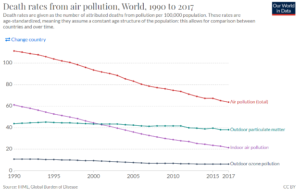
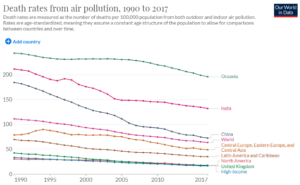
Cleaner Drinking Water
The next essential requirement of life is water. Things are getting dramatically better around the globe and the more industrially developed a country becomes, the greater its access to improved drinking water. In 2020, only 6% of the world population did not have access to an improved water source, and this has dramatically improved since 2000.
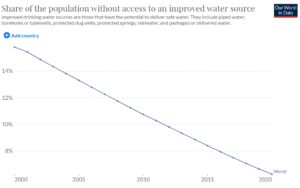

Improved access to clean drinking water is growing, especially in lower-income countries. And we continue to make progress globally every year.
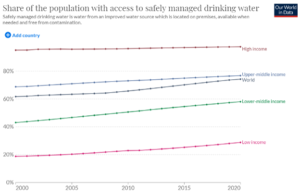
More Food Grown on Less Land
Food is humanity’s third greatest survival need. The United Nations explains that humanity now produces more than enough food to feed everyone on the planet. We also throw away half the consumable food we produce. So world hunger is a function of distribution, not production. In fact, the Journal of Sustainable Agriculture revealed back in 2012 that “we already grow enough food for 10 billion people,” a 25 percent bounty over our current global population. It’s why malnutrition and poverty are declining dramatically across the world.

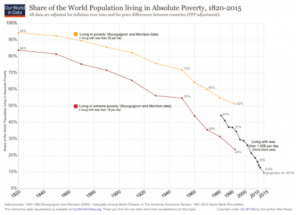
What is most striking here, is that because of technological innovation, we are producing more food than we can consume on less land! That means the earth itself is increasingly getting a break because we are farming smarter.

And this is true across all continents.
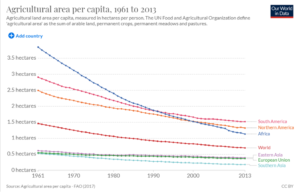
Dramatically Fewer Natural Disasters
But isn’t the world itself becoming a more dangerous and unhealthier place, with increased flooding, drought, and wildfires? We see evidence all the time in the news, right? The opposite of actually true.
A major 2019 study in the journal Global Environmental Change drawing from “one of the most complete natural disaster loss databases” reveals “a clear decreasing in both human and economic vulnerability” to “the seven most common climate-related hazards” by up to 80 to 90 percent over the last four decades. These hazards include all forms of flooding, drought, and deaths related to extreme wind, cold or heat. The trend lines are dramatic. This is because we are learning to live in greater harmony with nature, the exact opposite of the climate anxiety narrative.
The scholars at Our World in Data add that this also holds for other natural disasters such as earthquakes, volcano activity, wildfire, and landslides. “This decline is even more impressive,” they explain, “when we consider the rate of population growth over this period” revealing a greater than 10-fold decline in nature-related human deaths worldwide over the last century.
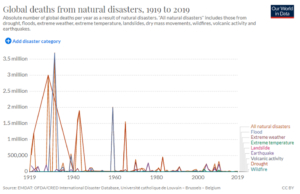
Bjørn Lomborg, whom the liberal Guardian feted as “one of the 50 people who could save the planet” highlighted an important angle on this fact recently in The Wall Street Journal. He explained,
“As the world has gotten richer and its population has grown, the number and quality of structures in the path of floods, fires, and hurricanes have risen. If you remove this variable by looking at damage as a percent of gross domestic product, it actually paints an optimistic picture. The trend of weather-related damages from 1990 to 2020 declined from 0.26% of global GDP to 0.18%.”
This is all the opposite of anxiety-producing news.
As the Creator’s stewards of the planet, we still have much work to do in improving the environment. But we must appreciate how the empirical data persuasively indicates the most significant trend lines for human thriving are moving in the right directions in profound ways for nearly everyone around the globe. And this is all happening as our population and economy continues to grow! The reason is because new people are not just stomachs that consume, but intellects that grow into innovative problem solvers. More people are the solution, not the problem.
Our children need to hear data like this so they can replace their rising climate anxiety with informed understanding that we are indeed heading in the right direction toward a healthier environment and a safer world.
Photo from Shutterstock.






